This was published 4 years ago
The long shot: delays, uncertainty and confusion in Australia’s vaccine rollout
By Rachel Clun
At 7.20pm on Thursday, a stony-faced Prime Minister walked into the blue room at Parliament House flanked by the Health Minister and the country’s top health officials. AstraZeneca, long touted as the workhorse of the vaccine rollout, was no longer the preferred choice for those aged under 50.
Just 15 minutes before facing the handful of journalists still in Parliament, the government had received advice from the Australian Technical Advisory Group on Immunisation that the vaccine rollout plan would have to be drastically changed.
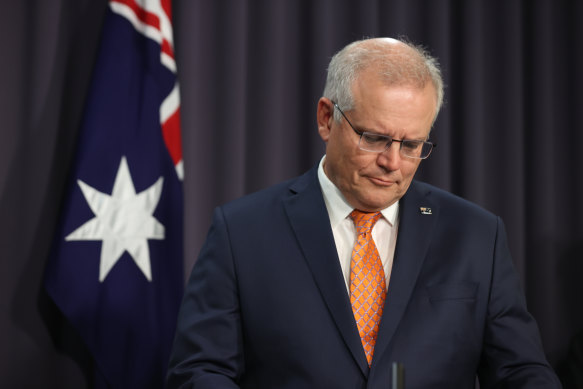
Prime Minister Scott Morrison announces the change of medical advice. His government’s vaccine rollout plan would have to be drastically changed.Credit: Alex Ellinghausen
Chief Medical Officer Professor Paul Kelly outlined the rare but serious blood-clotting side effect — venous thromboembolism — that has been seen in Europe, the UK and in one person in Australia after receiving the AstraZeneca vaccine.
“This is a very rare event. At the moment, it seems to be around 4 to 6 per million doses of vaccine. It’s only been found in the first dose of the AstraZeneca vaccine, usually within four to 10 days after that vaccine. But it is serious, and it can cause up to a 25 per cent death rate,” he said.
ATAGI weighed up the risk of the rare side effect against the benefit of the vaccine in a population where COVID-19 is not prevalent and advised the government the Pfizer vaccine should be preferenced for Australians aged under 50.
It seemed everything was off track, the country back to the days more than a year ago where late-night press conferences heralded changes to life as we knew it.
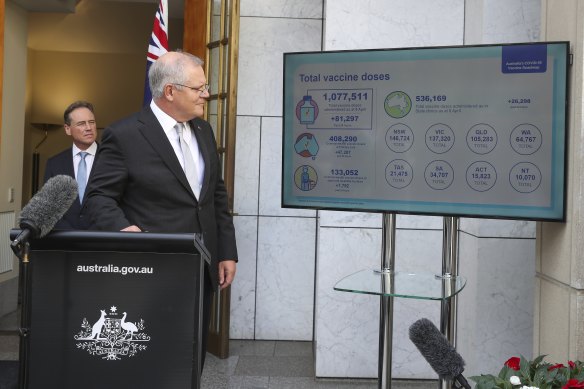
Health Minister Greg Hunt and Prime Minister Scott Morrison reveal new doses of the Pfizer vaccine could get the vaccination program back on track.Credit: Alex Ellinghausen
Back on track
But by Friday, Prime Minister Scott Morrison was able to report a new agreement for a further 20 million doses of the Pfizer/BioNTech vaccine may have saved the immunisation program from disaster.
“That is very welcome news, particularly in the light of the information that we received from ATAGI last night,” Mr Morrison said on Friday afternoon.
The news allowed a reset of the country’s troubled vaccine rollout, which was on the precipice of falling apart given the reliance on the Melbourne-produced AstraZeneca to vaccinate the majority of the country.
But how did it get to that point?
Europe’s early signs
The first hints there might be problems was in early March when Denmark reported cases of clotting, and put its use of the AstraZeneca vaccine on hold. Two hospital staff members had fallen ill with blood clots and cerebral haemorrhage within two weeks of their jab. One of them had died.
A number of European countries responded by pausing their use of the vaccine. At the time, the Australian government and medical experts remained cautiously confident there was no direct link between the vaccine and the clots.
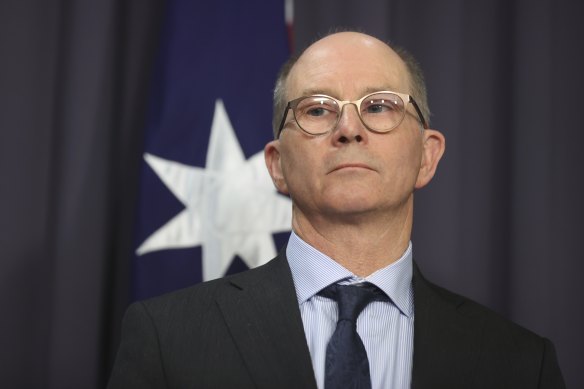
Chief Medical Officer Professor Paul Kelly. Credit: Alex Ellinghausen
Kelly said blood clots “happen in Australia fairly commonly, with about 17,000 cases every year, and health officials expected to see clots for some people around the time of vaccination”.
He said at that time there was no hard evidence of any specific link between AstraZeneca and blood clots.
On April 2 - Good Friday - a 44-year-old man was admitted to Box Hill Hospital in Melbourne’s eastern suburbs for blood clots. He had been vaccinated on March 22 - 11 days earlier.
ATAGI and the Therapeutic Goods Administration were advising the government to continue the vaccine rollout as there was still no concrete evidence linking the clotting disorders to the vaccine, but ATAGI did ask people to be alert for potential severe side effects, particularly severe, persistent headaches that occurred between four and 20 days after their vaccination.
Federal Health Department secretary Dr Brendan Murphy said the government would continue to listen to the independent expert health advice.
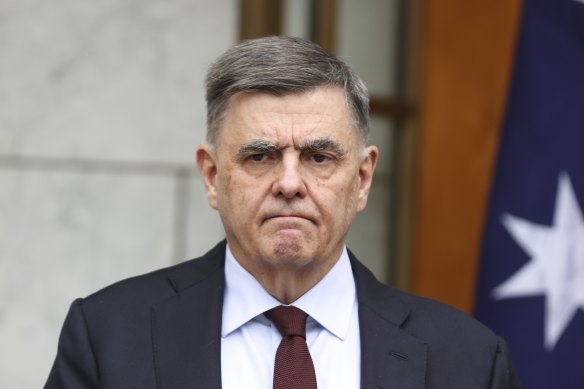
Health department secretary Dr Brendan Murphy.Credit: Alex Ellinghausen
“If ATAGI or TGA recommends a change we’ll act accordingly, but at the moment they’re not making that recommendation,” he said at the time.
Murphy said in Britain, where more than 18 million people had been given the AstraZeneca vaccine, there were only a few probable cases of blood clots. Britain was also continuing its rollout as the risk from COVID-19 remained far greater.
“We are talking about extremely rare events, perhaps one to two per million if you look at the UK, and the risk of dying of COVID is one to two per 100,” he said.
But more cases of the rare disorder were discovered across Europe and the UK.
At this stage, Australia’s medical regulators were in almost daily contact with their overseas counterparts as medical experts looked for links between the clotting and the vaccine.
Professor Kristine Macartney, who heads the National Centre for Immunisation Research and Surveillance and is also part of ATAGI, said there had been continuous meetings with Australian expert groups and international regulators.
“It was late nights, early mornings,” she said.
By Wednesday evening, Health Minister Greg Hunt said “they were just starting to get an impression from Europe that there may be causation”.
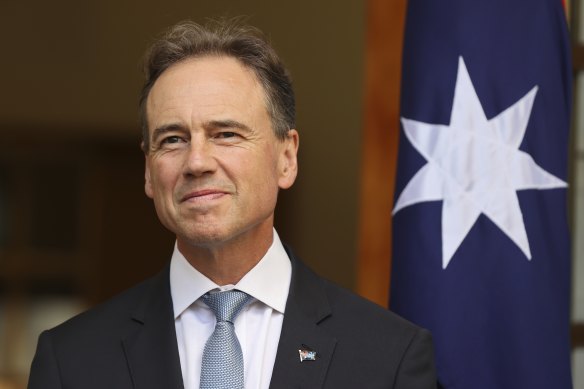
Health Minister Greg Hunt began talks with the head of Pfizer once the rare AstraZeneca blood clot link started to become clearer.Credit: Alex Ellinghausen
Hunt immediately hit the phone to call the head of Pfizer. It was the surest bet, with Novavax deliveries still months away and without regulatory approval. He told the company Australia might need to acquire more vaccines.
“We worked out the figure we’d need would be about 20 million to cover any additional under-50s, and to cover [children] if they did move to paediatric [vaccination] at some stage,” he said.
Hunt, flew from his home in Melbourne to Canberra on Thursday to prepare for potentially major changes to Australia’s vaccine program. Before he arrived, European regulators changed their advice on AstraZeneca.
The European Union’s medical regulator decided to list blood clots as a very rare side effect of the AstraZeneca vaccine, and the UK regulator decided to offer an alternative shot for those aged under 30, after a review of data around a rare blood-clotting condition in a small number of patients was linked to the vaccination.
ATAGI made the government aware on Thursday morning they were also now considering an aged-based recommendation.
Acquiring more vaccines
That was when the question of purchasing more Pfizer vaccines was raised with the Prime Minister.
“We put it to the Prime Minister ... ‘look, we don’t know how this will go, but we want to prepare on a what-if basis and be ahead of the curve’,” Hunt said. “That’s been our mantra together since January of 2020 ... move fast, move early on the basis of medical advice.”
By mid-Thursday morning, funding for the 20 million doses was approved by the government on an if-needed basis, subject to the advice of ATAGI.
On Thursday night, ATAGI made its recommendation.
“We really did not get the final advice until literally, just a couple of minutes after seven o’clock,” Hunt said. In a matter of minutes Morrison, Kelly and Murphy joined him to face the media and the nation.
In the background, the government had been working for two days on a new contract with Pfizer and by midday on Friday, the deal for more doses was struck.
That meant announcing massive changes to the vaccine program.
The new rollout plan
Besides recommending the Pfizer vaccine for people under the age of 50, ATAGI also recommended adults under the age of 50 should only be given AstraZeneca where the benefits clearly outweighed the risks. It also advised adults under 50 who had already received their first doses without experiencing serious side effects could safely be given their second dose.
Hunt said for now, phases 1a and 1b could continue mostly as they were, although provisions would have to be made for some.
“For those who may be immunocompromised or front-line workers who are under 50, then right now we are working with the states and territories and the medical authorities to revise that part of the program so they have access to Pfizer. That will take time,” he said.
General practitioners, lauded as the cornerstone of the rollout, were only meant to provide AstraZeneca shots. And pharmacies, from phase 2b, were going to be on hand to vaccinate many younger people who were less likely to have a regular GP.
Murphy said the GP program would be able to continue as planned for now.
“The GP program right through 1a and 1b will continue as it is. As we get to 2a, there are people over 50 and over 60 who will also be able to go to their GPs to get vaccinated,” he said.
“It’s true we planned in phase two to roll out pharmacies. We’re looking at how we’ll do that now. We need to recalibrate to see how we may get more Pfizer and how we deal with the under-50s as we get to phase 2b.”
What exactly these changes mean for phase 2b, and when the rollout will be completed, remains unclear. The government is unwilling to commit to any timeline for completing the vaccine rollout so close to the major change in direction, and won’t say for sure how it will be fixed.
The reluctance to commit to a hard timeline with so much uncertainty is understandable. Less than two months into the country’s vaccine rollout, we’ve already faced supply delays, communication trouble, and fallen well behind initial targets.
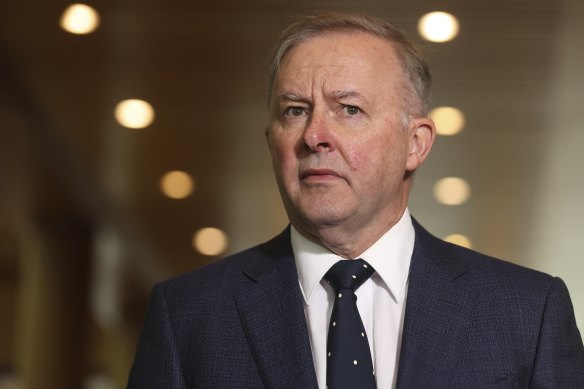
Opposition Leader Anthony Albanese said the government failed in not securing deals for more vaccines from the outset.Credit: Alex Ellinghausen
Labor leader Anthony Albanese said the rollout was now a debacle that could have been avoided with more work to obtain other vaccine options.
“Labor was warning for a long period of time that we needed to do what international best practice told us we should do, which is to have access to five or six vaccines,” he said on Friday morning.
He said getting the rollout right was critical not just for the country’s health but also the economy.
“If we don’t get the health response right, then we won’t be able to return our economic activity and our normal way of going about our lives, back to what it was before this pandemic.”
Hunt says the government has tried to be open with the public.
“We’ve responded immediately, but always to provide reassurance that we’ll get through it - what we know, and what we don’t know,” he said. “But here’s the reassurance on safety, here’s the reassurance on supply. And being very clear on what’s known and what’s next.”
Get our Coronavirus Update newsletter
Stay across the news you need to know related to the pandemic. Sent Monday and Thursday. Sign up here.